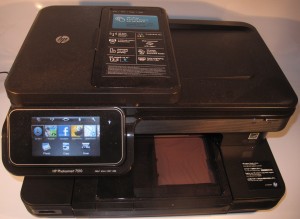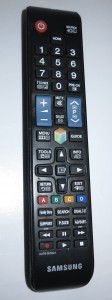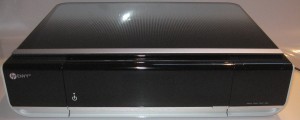Audio and VIdeo
Smart TV
There is still intense interest in the smart-TV platforms where your TV is effectively a computer connected to the Internet. This is more so with the idea of integrating multiple viewing screens ie the large TV screen, one or more computer screens, and the screens on tablets and smartphones.
Sony have been dabbling with the Google TV platform, mainly in the form of network video peripherals rather than a TV, which I will mention below. Of course, they are still maintaining their Bravia platform. They were also to promote this concept in a Las Vegas wedding at the Bellagio Wedding Chapel between “Bravia” (Sony’s Internet TV platform) and “Sony Entertainment Network” (Sony’s online content entity).
As far as the interactive-TV lineup goes, Sony have focused this function across their HX and EX “lounge-room” models with the HX series being ready for Skype once the user purchases an optional camera.
Samsung have devoted most of their press event to the TV being the “smart hub” of the connected home. This is with the use of a connected TV chassis that has a dual-core CPU, as well as building up the “Smart TV” platform around an app store and a video-content-distribution platform. They even are using an Android app as the TV’s remote rather than supplying the remote with the TV set. They even ran a competition for the development of a multi-screen app which makes best use of the TV screen alongside a smartphone or tablet screen.
As well, Samsung put forward an “open-frame” design for TV sets with a user-upgradable computer processor. This is in a similar way to how the desktop computer has been designed and is underscoring the fact that these smart TVs are really large-screen computers in their own right and are expected to last for in the order of ten or more years.
Even Lenovo had come to the fore with a 55” LCD set that is driven by the Android “Ice Cream Sandwich” operating system. This would link to their own app store and cloud services and have the usual “smart-TV” features like Wi-Fi connectivity and ability to use an SD card as storage.
Similarly, a “fork” of the Ubuntu Linux distribution, which was targeted at the Internet-enabled TV set, had been launched at this show.
Ultra-high-definition TV
Another main trend surfacing this year at the Consumer Electronics Show is ultra-high-definition TV, also known as UDTV or 4DTV. This is where images have a resolution of 3840×2160 pixels and is pitched at the very large screens of 103” and bigger.
LG is intending to demonstrate an 84” prototype set which works at this resolution while Sony even had the idea of having some of their Blu-Ray players upscale the 1080p video to the higher resolution offered by this newer technology.
3D TV
The main trends affecting this technology are glasses-free 3D screens where you don’t need to wear glasses to watch the 3D effect; use of cheaper cinema-style passive 3D glasses which don’t need to link to the set or require batteries; as well as standards-based active glasses systems.
Toshiba is launching a glasses-free QFHD 3D TV
OLED as a TV display technology
LG and Samsung have made efforts to bring the OLED display technology to the living-room TV size. Here, they have proven it by demonstrating 55” TV sets that use this technology rather than the LCD or plasma technologies for their screens.
There were rumours that Sony was to dump OLED technology for TV displays but they wanted to refine it to a cost-effective point for professional and consumer users. They have also shown a “Crystal LED” screen prototype which works in a similar vein to LED screens used in public places but implemented on 55” displays.
Other TV news
Some classic names of respect are using this fair to strengthen themselves in the American market. Westinghouse have launched a 3D TV but none of their sets came with Internet-enabled TV functionality. This was to keep their sets at an affordable price point.
RCA had rebuilt their name on a large run of TVs for the North American market as well as fielding a 55” Internet-enabled TV for the Latin-American market. They were using this show to launch some Android-powered mobile TV sets for the up-and-coming “Dyle” mobile / handheld terrestrial TV platform in North America.
Speaking of Dyle, Belkin and MCV were launching an array of equipment and accessories so that people can benefit from this mobile TV platform.
Home-theatre and Hi-Fi
Samsung had used this show to launch two soundbars with iPod / Galaxy S / Allshare (DLNA) integration with one being based on hybrid valve / digital amplification technology. They also ran with two Blu-Ray-based home-theatre-in-box setups with “Disc-Digital” which is Samsung’s implementation of the UltraViolet “digital video locker” service as well as the 7.1 channel unit being based on the above-mentioned valve-digital hybrid amplification technology. The other 5.1 channel version implements a wireless link for the back speakers and both systems use Wi-Fi to link to the home network.
Samsung even launched a home-theatre soundbar which can become two speakers and could link to sources via HDMI ARC (audio return path from HDMI 1.4-compliant TVs) or Bluetooth A2DP. RCA also launched a similar soundbar that connected to the home network and worked as a network media player for Netflix and similar services.
They are also implementing the “DIsc-Digital” UltraViolet implementation across the Blu-Ray player lineup at this year’s CES. One of the players is a similar size to a Discman and accepts discs through a slot while another of the players is a slimline form factor with HDMI inputs for TVs that don’t have enough HDMI sockets.
Sony have shown two Google-TV-based network video peripherals, the NSZ-GS7 which is a network media adaptor and the NSZ-GP9 which is a Blu-Ray player. As well, they have released two DLNA-capable Blu-Ray home theatre systems with full access to the Bravia Internet TV platform as well as a home-theatre receiver. Sony also released a few “HomeShare” DLNA speakers that connect to the Wi-Fi home network and have audio content pushed to them.
Panasonic have run with a large lineup of Blu-Ray players and Blu-Ray home-theatre systems. All of these connect to the home network and support DLNA functionality but the 3D-capable models and the home-theatre systems provide full access to Panasonic’s Viera Connect smart-TV platform including Skype and the Social Web for your existing TV.
These latest releases by Sony and Panasonic mean that you can use the cheaper and older TVs and have full access to the Internet-provisioned “smart TV” content and applications out there. In the case of the Panasonic 3D Blu-Ray players and home-theatres, add the Skype camera and you have just enabled a Skype-based video-conference setup,
Pioneer also used this show to launch the N-30 and N-50 audio-focused network media adaptors which work with DLNA 1.5 and Airplay network-media setups and the vTuner Internet-radio directory. They can handle 24-bit 192-kHz WAV or FLAC high-grade audio files and are Wi-Fi / Bluetooth ready with optional modules. The N-50 can also work as a high-grade digital-analogue converter for a CD player or MiniDisc deck.
Cameras
Samsung, Sony and Toshiba had launched cameras that were capable of uploading images to cloud-based photo-sharing services without the need for a computer. In the case of Sony, their Bloggie Live and Bloggie Sports cameras were being pitched as an alternative to the smartphone’s camera for Internet work.
Toshiba also exhibited a 3D camcorder with a built-in glasses-free 3D LCD screen so you can preview your 3D images properly. As well, Polaroid demonstrated a smartphone-style digital camera with a “proper” optical zoom lens – something that could be considered a bridge between a smartphone or digital camera.
Personal Lifestyle
Appliances
This show still hasn’t become a North-American showground for domestic appliances in a similar vein to the Internationaler Funkaustellung in Berlin. But LG was using this show to promote their “SmarThing” range of network-connected “white goods” which could be monitored from a computer.
Of course, Samsung also demonstrated a washing machine and clothes dryer that used a colour LCD touchscreen but was able to be controlled via an app on a smartphone. This means that you could track your washing from your phone’s screen.
Home Automation and Security
There has been some activity on this front mainly in the form of network-hardware vendors offering IP-enabled surveillance cameras, with TRENDNet offering a lineup of 12 units with varying features.
Other than that, the “Next Learning Thermostat” which learns your heating / cooling settings through the day was premiered at this show. Belkin also premiered the WeeMo home-automation system which is effectively an appliance-control module that responds to your smartphone.
Personal Health Care
There has been some more effort in developing online personal-health-care equipment which interacts with your smartphone or home network.
Withings, previously known for their Wi-Fi-connected bathroom scales, have released a baby scales which also links with the same network enablement and online health-monitoring setup as these bathroom scales. Similarly iHealth have released a wireless body-fat scales along with a wireless blood-pressure monitor and a “Smart GlucoMeter” glucose sensor for your iOS device. As well, FitBits released the Aria Wi-Fi Scale which is bathroom scales that link to your home network and measure weight, body-mass index and body-fat percentage.
IP Telephony
There has been some activity concerning voice and video Internet-based telephony. This is primarily with Skype being part of most of the “big-name” smart TVs and able to be added on to existing TVs through the use of this year’s Panasonic 3D Blu-Ray players and home-theatre systems. But Samsung also launched a Skype HD videophone unit for TVs and Biscotti launched a similar device for their own service.
RCA had demonstrated their voice-based IP telephony systems for business use while Ooma launched a cordless VoIP phone which has a colour LCD screen and can sync to Facebook for “picture caller-ID” images. $10 a month with the Ooma service provides for conferencing, second-line service and advanced call forwarding.
Tomorrow, in the last of the series, I will be talking about the network technologies that are to link these devices to the home network and the Internet.




